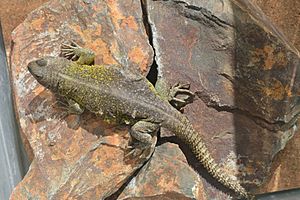Thorntail mountain lizard facts for kids
Quick facts for kids Thorntail mountain lizard |
|
|---|---|
 |
|
| Conservation status | |
| Scientific classification | |
| Genus: |
Phymaturus
|
| Species: |
mallimaccii
|
Phymaturus mallimaccii, also known as the thorntail mountain lizard, is a special kind of lizard. It belongs to the Liolaemidae family. You can find this lizard living in the mountains of Argentina in South America.
Contents
About the Thorntail Mountain Lizard
The thorntail mountain lizard is a fascinating reptile. It was first described by a scientist named Cei in 1980. These lizards are known for living in rocky, high-altitude areas. They are well-adapted to their cool mountain homes.
Where It Lives
This unique lizard makes its home in the Andes Mountains of Argentina. It prefers rocky areas and high elevations. These lizards often live among cracks and crevices in rocks. This helps them find shelter from predators and harsh weather. Their habitat can be quite cold, especially at night.
What It Looks Like
The thorntail mountain lizard gets its name from its tail. While not always spiky, some Phymaturus lizards have rough scales. This helps them blend in with their rocky surroundings. Their colors can vary, often matching the rocks they live on. This camouflage is important for staying safe.
What It Eats
Most Phymaturus lizards are herbivores. This means they mainly eat plants. They might munch on small leaves, flowers, or other plant parts. Eating plants helps them get the energy they need to survive in their tough mountain environment.
Life in the Mountains
Living in the mountains means dealing with cold temperatures. These lizards are ectotherms, meaning their body temperature depends on their surroundings. They often bask in the sun on rocks to warm up. When it gets too cold, they hide in rock crevices. This behavior helps them control their body temperature.
Protecting This Lizard
The thorntail mountain lizard is currently listed as "Vulnerable" (VU). This means its population might be at risk. Scientists and conservationists work to protect these lizards. They study their habitats and behaviors. Protecting their mountain homes is key to their survival.
See also
- In Spanish: Phymaturus mallimaccii para niños


